

[
] 113
ening forest biodiversity, environmental benefits and
welfare implications. The attainment of these objectives
is supported by the diversification and strengthening
of know-how in the forest sector, along with increased
Finnish contributions to international and EU-level
forest policy development.
New opportunities
The related goals of strengthening forest-based busi-
nesses and increasing the value of forest-based
production are implemented through the complemen-
tary Strategic Programme for the Forest Sector, drawn
up by the Ministry of Employment and the Economy in
2009. This programme includes projects and initiatives
designed to identify and enhance business opportuni-
ties, promote wood construction, expand wood-based
energy production and support related research and
development work.
The NFP has ambitious targets for increasing the
amounts of wood harvested annually from 50 million m
3
today to 70 million m
3
by 2015, corresponding to about
70 per cent of the total annual growth of Finland’s forests.
The programme particularly aims to promote the use of
wood and refined wood-based biofuels.
These increases should generate plenty of new employ-
ment in forestry, transportation and energy production
in rural areas, but there is an urgent need to implement
cross-sectoral policies to ensure the availability of suit-
ably trained workers and transportation infrastructure.
programme, and the comprehensive monitoring and evaluation of
its implementation, conducted by independent research institutes
in collaboration with the Finnish Forest Research Institute (Metla).
The key body responsible for shaping and assessing the NFP is
the National Forest Council (NFC), whose members include repre-
sentatives from the national forest owners’ association, the forest
industries, forestry, sawmill and papermaking unions, environmen-
tal NGOs and the indigenous Sámi people’s parliament, as well as
senior personnel from Government agencies and the ministries of
agriculture and forestry, employment and the economy, the environ-
ment, finance, social affairs and health, and education and culture.
Building a bioeconomy
The NFP complements other national strategies and policies, includ-
ing Finland’s Strategy for Sustainable Development, the National
Climate and Energy Strategy, a national renewable energy package
announced in 2010, and the National Strategy and Action Plan for
Biodiversity in Finland 2006-2016.
The NFP’s mission – to generate increased welfare through
diverse sustainable forest management – acknowledges the multi-
ple roles of forests in providing both economically valuable products
and non-material benefits. The programme’s vision sees Finland as
‘a responsible pioneering country in the future global bioeconomy,
where forest-based livelihoods are competitive and profitable, and
biodiversity and the other environmental benefits derived from
forests are enhanced’.
The NFP is based on three objectives derived from the vision:
strengthening forest-based business and increasing the value of
production; improving the profitability of forestry; and strength-
Forests cover more than three quarters of Finland
Forestry work is conducted responsibly, safely and professionally
in Finland, where 95 per cent of all forests are covered by forest
certification schemes designed to guarantee that products are made
from sustainably harvested wood
Image: Hannu Vallas
Image: Ministry of Agriculture and Forestry
















